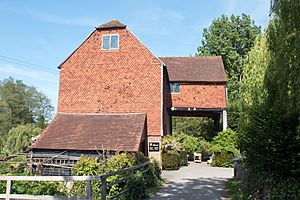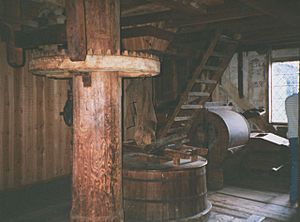Shalford Mill facts for kids
Quick facts for kids Shalford Mill |
|
|---|---|

View of the mill from the west.
|
|
| Type | Watermill |
| Location | Shalford, Surrey |
| OS grid reference | TQ 00106 47635 |
| Built | 18th Century |
| Owner | National Trust |
|
Listed Building – Grade II*
|
|
| Official name: Shalford Mill | |
| Designated | 14 Jun 1967 |
| Reference no. | 1294360 |
| Lua error in Module:Location_map at line 420: attempt to index field 'wikibase' (a nil value). | |
Shalford Mill is an old watermill located in Shalford, near Guildford, Surrey, England. It was built in the 1700s. This special building is listed as Grade II*, meaning it is very important and protected.
The mill sits on the River Tillingbourne. In 1932, a unique group of young women called Ferguson's Gang helped save the mill. They gave it to the National Trust, an organization that protects historic places.
Contents
A Look Back in Time
Early Days of the Mill
A mill has stood on this spot for a very long time. Records from the Domesday Book in 1086 show a mill here. This was one of five mills in the large area of Bramley.
Over the centuries, different families owned the mill. In the 1400s, John atte Lee was the owner. Later, in the 1500s, Sir Edmund Walsingham owned it. In 1599, George Austen bought the mill.
Building the Current Mill
The mill you see today was built around 1750. John Mildred of Guildford constructed this timber-framed building. It was quite unusual because it had two separate mills inside. Each mill had its own waterwheel and machinery.
The Mildred family ran the mill for most of the 1700s. John, then his sons Thomas and John, and later his grandson Daniel, operated it. In 1794, the mill was sold to Robert Austen. His family, later known as the Godwin-Austens, owned it for many years.
Changes Over Time
The eastern part of the mill stopped working around 1870. Its machinery was then removed. The western part continued to operate until 1914. After that, the mill was used for storing seeds and then furniture. By 1927, it was no longer in use.
How Ferguson's Gang Saved the Mill
Shalford Mill was in danger of being torn down. Its old timbers might have been sold, and the land used for new buildings. But then, Peggy Pollard (also known as Bill Stickers) and Brynhild Catherine Jervis-Read (also known as Sister Agatha) stepped in. They were part of a group called Ferguson's Gang.
They convinced the Godwin-Austen family to give the mill to the National Trust. The Gang promised to raise money for its repairs and future upkeep. A special architect named John Eric Miers Macgregor helped with the repairs. He later joined Ferguson's Gang and was called "The Artichoke." Even Major Arthur Godwin-Austen, the head of the family, joined the Gang. He was known as "The Pious Yudhishthira."
From 1932 until 1966, Shalford Mill was the main meeting place for Ferguson's Gang.
Inside the Gang's Headquarters
Today, the current resident of Shalford Mill sometimes opens the Gang's headquarters to visitors. You can see items from the 1930s there. There are even two bunk beds saved from the R100 airship!
The National Trust turned the eastern half of the mill into a home. The western half, with its old machinery, was kept and fixed up. However, it does not work anymore.
Exploring the Mill
Mill Design and Structure
Shalford Mill was built to a very high standard. This showed how important John Mildred was. The building has a wooden frame and a roof made of clay tiles. The walls are covered with tiles up to the brick base.
The windows have diamond-patterned leaded lights. These match the tiling on the walls. A unique feature of this mill is its "lucam." This is a part of the upper floor that sticks out over the road. It made it easy to load and unload wagons.
Mill Machinery
Originally, each side of the mill had two pairs of millstones. The millstones on the eastern side were used to make fine flour for people to eat. The western side had one pair for grinding animal feed and another for grinding corn.
Each pair of millstones was powered by a large water wheel. These wheels were about 4.3 meters (14 feet) across. After the eastern side closed, a third pair of stones was added to the western half.
The Millers
Even though the Mildred family owned the mill, they likely hired people to do the actual grinding. After the mill was sold in 1794, we know some of the millers who worked there:
- John Sparkes worked until 1830.
- John Lambert followed him.
- John's sons, Charles, Abraham, and Daniel Lambert, also worked there.
- George Lambert, John's grandson, worked until 1882.
- Thomas and Frederick Botting took over next.
- Henry Botting was the last miller, working until 1917.
Visiting Shalford Mill
You can visit Shalford Mill during the summer months. It is open to the public on Wednesdays and Sundays.


